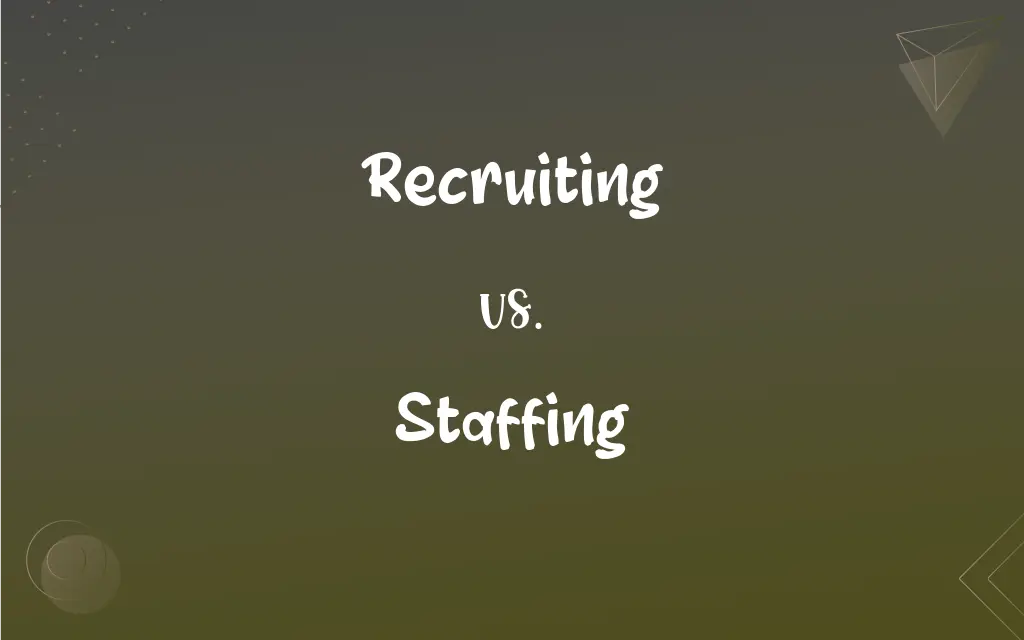Recruiting vs. Staffing: What's the Difference?
Edited by Aimie Carlson || By Janet White || Published on November 9, 2023
Recruiting is the process of attracting and selecting candidates for employment, while Staffing involves filling and managing positions within an organization.

Key Differences
. Recruiting is primarily concerned with the identification, attraction, and selection of potential candidates for a job role. It's the first step in the hiring journey where organizations actively seek individuals who fit the requirements of a specific job description. Staffing, on the other hand, goes beyond just hiring. It encompasses the entire process of filling a job role, which might include hiring, training, and managing the workforce.
Recruiting tends to be a proactive endeavor. Companies employ various strategies, from job advertisements to campus placements, to find the right talent. The primary focus of Recruiting is to ensure a rich and relevant talent pool from which the best candidates can be chosen. Conversely, Staffing takes a more comprehensive approach. It's not just about finding the right people; it's about ensuring that they are rightly placed, trained, and integrated into the organization.
When an organization is expanding, the emphasis might be on Recruiting. They'll be looking to attract new talent to fuel their growth ambitions. Staffing, however, becomes a continual process. Whether it's replacing an employee who has left or temporarily filling a position, Staffing ensures that the organization runs smoothly without any gaps in its workforce.
Recruiting can often be a short-term, project-based activity, especially when an organization is filling a specific role. It ends once the right candidate is selected. Staffing, by its very nature, is ongoing. It's about maintaining an equilibrium in the workforce, ensuring that there are no shortages or surpluses. While Recruiting can be seen as the starting point, Staffing is the journey, ensuring the right distribution and management of human resources.
In essence, while both Recruiting and Staffing are integral to human resource management, their focus and scope differ. Recruiting is about casting the net wide and finding the right talent. In contrast, Staffing is about ensuring that this talent is effectively utilized, managed, and retained within the organization.
ADVERTISEMENT
Comparison Chart
Focus
Attracting and selecting candidates.
Filling, managing, and retaining positions.
Duration
Often short-term or project-based.
Ongoing process.
Scope
Specific to certain job roles.
Encompasses all positions within an organization.
Outcome
Ends with the selection of a candidate.
Continuous management of workforce distribution.
Nature
Proactive talent search.
Comprehensive approach to workforce management.
ADVERTISEMENT
Recruiting and Staffing Definitions
Recruiting
Recruiting is the act of attracting potential employees to an organization.
The tech company is heavily investing in Recruiting to find top-tier engineers.
Staffing
Staffing involves managing and allocating human resources within a company.
Staffing challenges during peak season often required temporary hires.
Recruiting
Recruiting aims to build a pipeline of potential candidates for an organization.
Their aggressive Recruiting campaign attracted many industry professionals.
Staffing
Staffing ensures that an organization's workforce needs are consistently met.
The HR department is responsible for Staffing and employee training.
Recruiting
Recruiting encompasses activities related to identifying talent for open positions.
The HR team is busy Recruiting for multiple roles this month.
Staffing
Staffing is the act of filling job roles, both temporary and permanent, within an organization.
The Staffing agency provided the company with short-term contract workers.
Recruiting
Recruiting refers to the process of screening and selecting suitable candidates for a job.
Effective Recruiting strategies are crucial for a company's growth.
Staffing
Staffing includes tasks related to managing the distribution and roles of employees.
Proper Staffing ensures smooth operations without gaps in the workforce.
Recruiting
To enlist (persons) in military service.
Staffing
A stick or cane carried as an aid in walking or climbing.
Recruiting
To strengthen or raise (an armed force) by enlistment.
Staffing
A stout stick used as a weapon; a cudgel.
Recruiting
To hire or enroll, or seek to hire or enroll (new employees, members, or students).
Staffing
A pole on which a flag is displayed; a flagstaff.
Recruiting
To renew or restore (health or vitality, for example).
Staffing
A rod or baton carried as a symbol of authority.
Recruiting
To enlist personnel in a military force.
Staffing
Pl. staffs A rule or similar graduated stick used for testing or measuring, as in surveying.
Recruiting
To recruit new employees, members, or students.
Staffing
A group of assistants to a manager, executive, or other person in authority.
Recruiting
A newly engaged member of a military force, especially one of the lowest rank or grade.
Staffing
A group of military officers assigned to assist a commanding officer in an executive or advisory capacity.
Recruiting
A new member of an organization.
Staffing
The personnel who carry out a specific enterprise
The nursing staff of a hospital.
Recruiting
Present participle of recruit
Staffing
Something that serves as a staple or support.
Recruiting
The process by which a person is recruited; recruitment.
Staffing
(Music) A set of horizontal lines and intermediate spaces used in notation to represent a sequence of pitches, in modern notation normally consisting of five lines and four spaces. Also called stave.
Recruiting
Recruiting involves assessing the suitability of candidates for specific roles.
Despite intense Recruiting efforts, they struggled to find the right fit for the manager's role.
Staffing
To provide with a staff of workers or assistants.
Staffing
To serve on the staff of (an organization).
Staffing
Present participle of staff
Staffing
The practice of hiring and firing staff
Staffing
The personnel required for some project
Staffing
Staffing pertains to the process of hiring and retaining employees in an organization.
The company prides itself on its effective Staffing strategies.
FAQs
How do companies measure Recruiting effectiveness?
Metrics like time to hire, quality of hire, and cost per hire are used.
What are the challenges of Staffing?
Challenges include finding the right fit, managing workforce distribution, and retaining employees.
How does temporary Staffing work?
Temporary Staffing involves hiring employees for short-term assignments or specific projects.
Can technology automate the Recruiting process?
Yes, with tools like AI and machine learning, many aspects of Recruiting can be automated.
What roles do Staffing agencies play?
Staffing agencies help companies find suitable candidates, especially for temporary or specialized roles.
How do companies forecast Staffing needs?
They analyze business growth, project requirements, and historical hiring data.
What skills are essential for a Recruiting professional?
Skills include communication, analytical thinking, and knowledge of hiring trends.
What tools are used in Recruiting?
Recruiting tools include job boards, applicant tracking systems, and recruitment software.
Are there specific laws related to Staffing?
Yes, there are employment laws that companies must adhere to when Staffing.
How do social media platforms aid Recruiting?
Platforms like LinkedIn help in sourcing candidates, building employer brand, and advertising job vacancies.
How does Staffing contribute to business success?
Effective Staffing ensures the right talent is in place, leading to increased productivity and business growth.
Can Recruiting be done internally?
Yes, many companies have internal Recruiting teams, while others use external agencies.
Is diversity important in Recruiting?
Yes, diversity in Recruiting brings varied perspectives, promotes inclusivity, and drives innovation.
What's the difference between Staffing and workforce planning?
Staffing is about filling roles, while workforce planning is strategizing to meet future human resource needs.
Are there ethical considerations in Recruiting?
Yes, ensuring fairness, avoiding discrimination, and being transparent are crucial.
What are passive candidates in Recruiting?
Passive candidates are those not actively looking for a job but may be interested if approached.
How do Staffing metrics help businesses?
Staffing metrics provide insights into hiring efficiency, employee retention, and workforce productivity.
Is Staffing only about hiring?
No, Staffing includes hiring, training, managing, and sometimes even terminating employment.
How has digital transformation impacted Recruiting?
Digital tools, online assessments, and virtual interviews have streamlined the Recruiting process.
Can Staffing strategies evolve?
Yes, Staffing strategies can change based on business needs, market conditions, and workforce trends.
About Author
Written by
Janet WhiteJanet White has been an esteemed writer and blogger for Difference Wiki. Holding a Master's degree in Science and Medical Journalism from the prestigious Boston University, she has consistently demonstrated her expertise and passion for her field. When she's not immersed in her work, Janet relishes her time exercising, delving into a good book, and cherishing moments with friends and family.
Edited by
Aimie CarlsonAimie Carlson, holding a master's degree in English literature, is a fervent English language enthusiast. She lends her writing talents to Difference Wiki, a prominent website that specializes in comparisons, offering readers insightful analyses that both captivate and inform.






























































